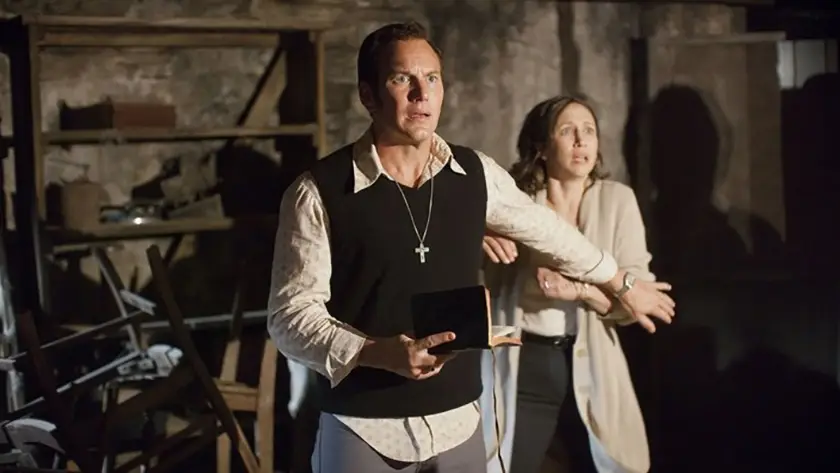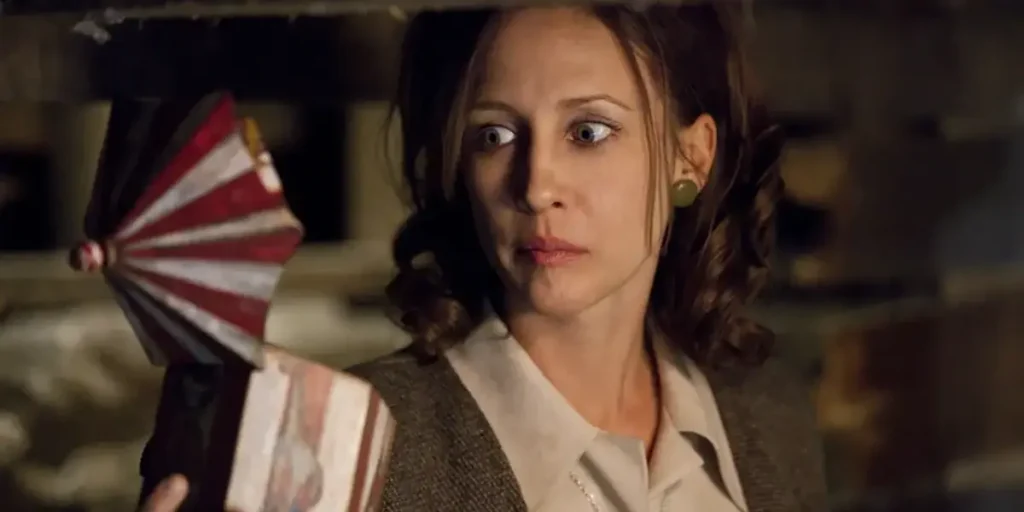While its tools of fright are familiar, The Conjuring treats those tools with respect and restraint in order to craft an immersive haunted house attraction.
Director: James Wan
Genre: Horror, Mystery, Thriller
Run Time: 112′
Release Date: July 19, 2013
Where to Watch: Digital & VOD
Welcome to The Conjuring, another movie in a long line of horror films trying to convince the public that moving into big countryside houses is the worst idea you can have. I know I’m sticking to the big cities for the rest of my life.
Directed by James Wan, The Conjuring follows Ed (Patrick Wilson, of Aquaman and the Lost Kingdom) and Lorraine Warren (Vera Farmiga, of Godzilla: King of the Monsters), a demonologist and a clairvoyant, based off of the two real life paranormal investigators. One day, they’re called by Roger (Ron Livingston, of The Flash) and Carolyn Perron (Lili Taylor, of Fear Street: Prom Queen), who claim their family is being terrorized by malicious paranormal activities. Upon further inspection, Ed and Lorraine start to realize the truth of the unknown entity behind these spectral attacks.
If that sounded like a simple ghost story premise, that’s because it is. The Conjuring is not complicated. The first act sets up the ghostly activity, the second act escalates it, and the third act resolves it. The characters are your typical happy family members, and everything culminates in a big exorcism. The backstory behind the paranormal activity is connected to another vengeful spirit. Horror aficionados will find plenty of familiar tropes here, and normally that’d be cause for a negative review.
Yet with The Conjuring, I am once again reminded that execution is what truly matters in the end. The tools that The Conjuring uses might be familiar, but it uses those tools in an absolutely expert manner to craft an immaculate sense of suspense. For almost 40 minutes, there is no real jumpscare. Instead all we get are creaking doors, terrified expressions, or soundless reveals in the background.
I need to give one particular example because it was so good. There is a scene where Carolyn plays “hide and clap” with one of her daughters while blindfolded. She hears what she thinks is her daughter clapping, and goes into a room with a closet. While she is searching, the closet opens on its own in the background, and then a pair of hands emerge from it to clap. However, it isn’t accompanied by any loud noises, and the scene doesn’t switch immediately to a ghost bursting out of the closet like the world’s nastiest jack-in-the-box. Instead, the scene ends with her daughter emerging elsewhere, leaving the audience with only the confirmation and dread that something is definitely very wrong.
All of this leads up to when the film finally decides to unleash its jumpscares. Many people bash jumpscares in horror movies, but I feel they need to be more specific; it’s not the jumpscares themselves that’s bad, but their overuse. If I suddenly started SCREAMING at you out of nowhere every five minutes, you’d be startled, yes, but you’d also find it would quickly become predictable and annoying. Horror movies work the same way. I know a jumpscare is coming; it’s inevitable in a horror movie. However, The Conjuring seems to be aware of this, as it presents multiple scenarios (like the closet scene above) where a jumpscare is to be expected, and yet it keeps its restraint, leaving the audience even more on edge as to when the film will finally say “gotcha!”. Thus, through its buildup, The Conjuring truly earns its first jumpscare.
What complements this suspense are the technical aspects of the film, such as the distinct absence of bombastic soundtracks or the actors all giving a thoroughly convincing performance of being scared out of their souls. The element that shines above those, however, is the camerawork. The camera either moves steady and sweeping through the house, or follows the characters more unsteadily, most likely as a handheld. The former controls the pace at which you’re allowed to take in visual information, building suspense through the scarcity of said info, and the latter immerses you into the scene by acting as the POV of one of the characters.
Even when things start to escalate more in the climax, it still feels earned…somewhat. After Ed and Lorraine get called in, we still spend several scenes with the two families together and interacting. This allows them to feel, while not particularly deep or complex, more than just ghost fodder and gives me a reason to feel invested in their survival. So when the supernatural beings start getting more violent, it still feels like a natural progression because we got to care for the victims.
However, the reason I added in the “somewhat” in the previous paragraph is that I feel The Conjuring loses its restraint a bit too much in the very height of its climax. This is when Ed and Lorraine attempt to exorcise the demonic entity. Things turn much more bombastic, with objects flying around and people becoming possessed. However, this means the tone shifts to a more fantastical one, and I am not sure if the level at which the film commits to that tone is in line with everything that came before.

In addition, there’s also the issue of logic. The movie never explains exorcism or other demonic rituals in depth. So when it is time for the exorcism, I have next to no basis as to how difficult this ritual is, how risky it can be, or how it even works. Therefore when Ed is chanting in Latin and spraying Holy Water, while I was attached to the scene emotionally, I felt detached logically. That is still preferable compared to the other way around, which is why I remained immersed, but the exorcism was still the weakest part of the film for me.
The best way to describe The Conjuring is to compare it to an amusement park haunted house. Yes, many of its moments are familiar, and its paranormal entities aren’t too creative. However, even if you know what you’re facing are animatronics and overworked part-timers, if the attraction does a good enough job immersing you into its scare, you forget that everything is staged.
The Conjuring works the same way. It is what I would call a perfect base template on how to create suspense and buildup. I’ll remember it better as an experience than a story, which some could argue is a weakness. Considering that the main point of watching a horror movie is to make you sleep with your lights on, though, I’d say that is more of this movie’s strength.
The Conjuring (2013): Movie Plot & Recap
Synopsis:
When supernatural horrors start threatening their family, Roger and Carolyn Perron decide to seek help from renown paranormal investigators Ed and Lorraine Warren.
Pros:
- The film boasts expert buildup and escalation.
- The suspense is masterful, crafted through its camerawork.
Cons:
- The climax can feel a little over the top at times.
- Its themes or supernatural threats aren’t anything creatively new.
The Conjuring (2013) is now available to watch on digital and on demand.
Loud and Clear Reviews has an affiliate partnership with Apple, so we receive a share of the revenue from your purchase or streaming of the films when you click on some of the links on this page. This won’t affect how much you pay for them and helps us keep the site free for everyone.

